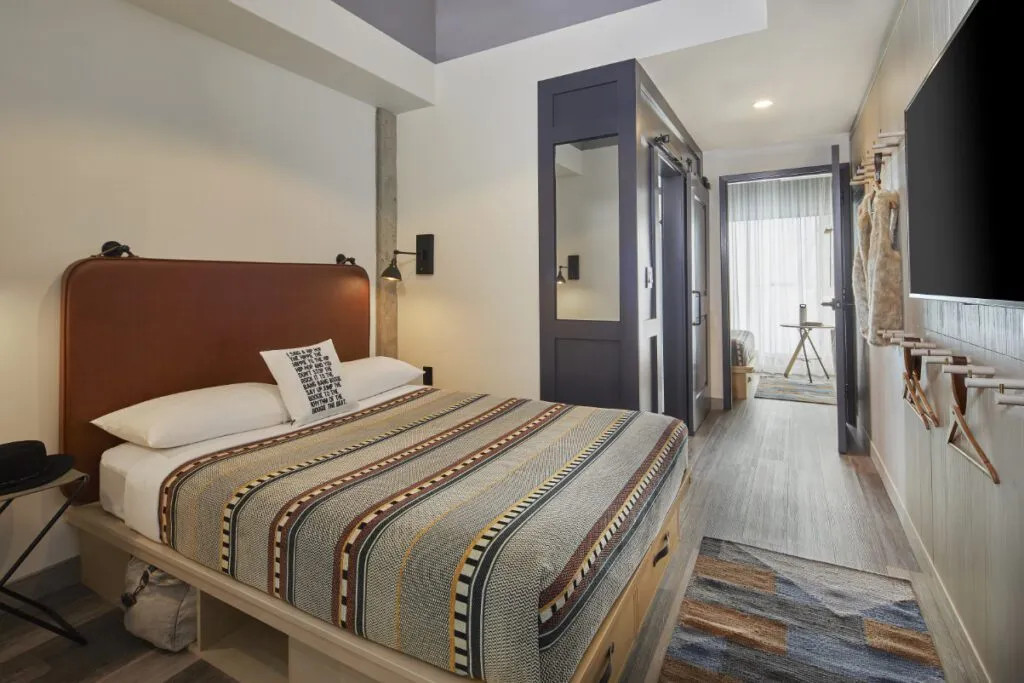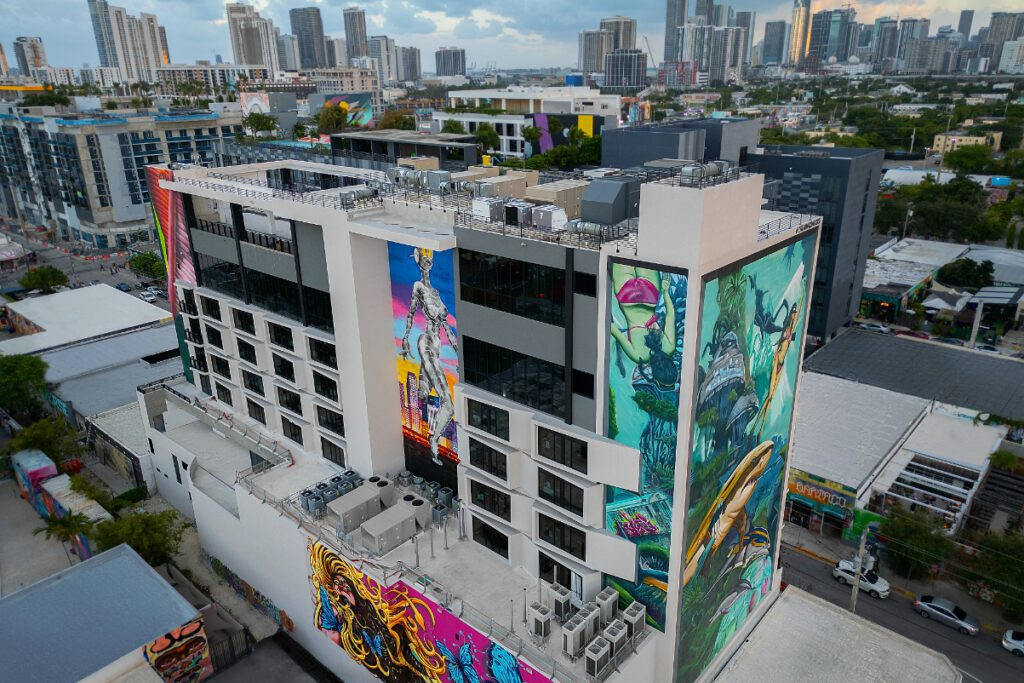Hotel chains can often seem indistinguishable, blending into a predictable experience. However, Marriott aimed to disrupt this with Moxy Hotels, a brand designed to capture attention with its vibrant and unconventional approach, much like the neon signs that often adorn its lobbies. Initially targeting Gen Z, Moxy has now been around for a decade. The question is, can it continue to evolve and expand without losing its youthful appeal?
Moxy Hotels: Key Innovations
Launched by Marriott in 2014, Moxy Hotels has rapidly grown to include over 135 properties, with further expansion on the horizon. The brand is known for its innovative approach, focusing on:
- Minimalist Rooms: Small, efficiently designed rooms that prioritize functionality and style over traditional hotel room size.
- Vibrant Social Spaces: Lobbies that are transformed into dynamic hubs for socializing, working, and entertainment, moving away from the conventional, often underutilized hotel lobby.
- Local Adaptation: A commitment to incorporating local culture and preferences into each hotel, creating unique guest experiences while maintaining brand consistency.
Summary: Moxy’s Decade of Disruption
Moxy Hotels emerged as Marriott’s response to the evolving preferences of modern travelers, particularly Gen Z, by challenging traditional hotel norms. Instead of emphasizing large, amenity-filled rooms, Moxy prioritized compact, stylish spaces and energetic, multifunctional lobbies. This “travel tweak” – rethinking the hotel experience – has resonated with a broad audience seeking experiences over extravagance. By adapting to local cultures while maintaining core brand elements, Moxy is navigating the path to sustained relevance and growth in the global hotel industry.
Remember back in 2014? Pharrell Williams’ “Happy” was everywhere, the ALS Ice Bucket Challenge dominated social media feeds, and Marriott decided it was time for a fresh, select-service brand aimed at capturing the attention of 20-somethings.
Moxy Hotels was Marriott’s venture into “cool.” Against industry expectations, it has proven to be quite successful. Celebrating its 10th anniversary, Moxy boasts over 135 operational hotels and plans to add 17 more in Europe alone by 2025. This growth underscores a significant shift in hotel design and guest expectations – a real “Hotels Travel Tweaks” moment.
The concept of Moxy took several years to refine, but the initial formula was relatively straightforward. Imagine combining the functional design of Ikea (the parent company of Ikea had manufacturing connections to the early Moxy prefabricated units) with the space-efficiency sought by developers aiming to maximize guest capacity per square foot. Locate these hotels in up-and-coming neighborhoods or areas lacking affordable hotel options for younger travelers, and then heavily infuse it with “lifestyle” branding.
“We envision it as a bar that happens to have rooms attached,” explained Brian Jaymont, Senior Director and Global Brand Leader, highlighting the brand’s social-first approach. This vision represents a fundamental “travel tweak” in how hotels position themselves.
De-emphasizing the Traditional Hotel Room
For decades, the hotel industry operated under the assumption that the hotel room was paramount. Spacious rooms, luxurious bedding, and extensive in-room amenities were the benchmarks of quality. Moxy, however, fundamentally challenged this notion, implementing a significant “hotels travel tweak.”
Moxy’s rooms are compact, averaging around 185 square feet, and intentionally lack traditional hotel furniture like dressers and closets. Instead, guests typically find a simple peg strip for hanging clothes, a space-saving foldable desk, and minimal additional furnishings. This design philosophy is a key “travel tweak” aimed at efficiency and modern aesthetics.
This design would have been considered radical in previous generations. However, it appealed to millennials and Gen Z travelers accustomed to smaller urban living spaces and drawn to minimalist lifestyles inspired by figures like Marie Kondo. This resonated with a demographic prioritizing experience and social interaction over room size – a crucial “travel tweak” understanding.
Hotel investors and owners were attracted to the cost benefits of Moxy’s design, which allowed for more rooms within smaller footprints. This efficiency made previously unsuitable locations economically viable for hotel development. From repurposed office buildings to former banks, Moxy is a brand perfectly suited for “adaptive reuse,” demonstrating a smart “travel tweak” in urban development and hotel expansion.
 A queen suite at the Moxy Hotel in Columbus, Ohio's Short North district. Source: Marriott
A queen suite at the Moxy Hotel in Columbus, Ohio's Short North district. Source: Marriott
The Rise of Lively Lobbies
Historically, select-service hotel lobbies were primarily decorative spaces, rarely used by guests for anything beyond passing through. Moxy revolutionized this concept, another significant “hotels travel tweak,” by transforming lobbies into vibrant, multifunctional spaces serving as bars, cafes, coworking areas, and event venues.
Moxy distinguished itself as the first Marriott brand to eliminate the traditional front desk. Instead, guests check in at the bar, immediately setting a tone of casual interaction and social engagement. This is a core “travel tweak” in service and guest interaction.
Hotel operators appreciate Moxy’s success in creating bustling social hubs that attract both hotel guests and local residents. These lively lobbies and bars are not just about atmosphere; they are designed to generate high-profit food and beverage revenue, a smart “travel tweak” in hotel profitability strategies.
While brands like CitizenM and Yotel also pioneered the small-rooms-big-lobbies concept, Moxy carved out its niche with a distinct aesthetic and price point, further refining this “travel tweak” in hotel design.
The Challenge: Maintaining Relevance
When Moxy was initially launched, its target demographic was described by Jaymont as backpackers in their mid-20s seeking affordable lodging between adventures. This initial focus was a specific “travel tweak” targeting a niche market.
Today, the brand aims to attract a broader “psychographic” of travelers across age groups who prioritize experiences over luxury and appreciate hotels that offer a taste of local culture. This evolution is a crucial “travel tweak” in market positioning.
“We recognize that we can’t appeal to everyone, and we are comfortable with that,” Jaymont stated. This strategic focus allows Moxy to tailor its offerings and maintain a distinct brand identity – a key “travel tweak” in brand management.
Moxy conducts ongoing market research to stay aligned with the evolving preferences of its target audience, ensuring its “travel tweaks” remain relevant and effective.
 Skyline view of the Moxy Miami Wynwood Hotel. Source: Marriott
Skyline view of the Moxy Miami Wynwood Hotel. Source: Marriott
Like Ikea, But Designed for Overnight Stays
As Moxy’s footprint expands to diverse locations like Wynwood in Miami, Tanzania, Colombia, and the Middle East, the brand faces the challenge of adapting to local contexts while ensuring a consistent brand experience. This global expansion necessitates continuous “hotels travel tweaks” for cultural relevance.
Moxy’s solution is to standardize the fundamental room experience while allowing public spaces to become platforms for local expression. This balanced approach is a smart “travel tweak” in global brand adaptation.
“We deliberately avoid using identical artwork in lobbies across all locations,” explained Aliya Khan, VP of Design Lifestyle Brands at Marriott. “We customize each project to reflect local needs, collaborating with local artists and artisans to create spaces that feel authentic to their surroundings and curate lobby soundtracks that resonate locally.” This localized approach is a significant “travel tweak” in hotel design philosophy.
In Wynwood, Miami, local graffiti artists have transformed the Moxy hotel into an extension of the neighborhood’s renowned street art scene. In Tanzania, Moxy collaborates with local craftspeople to design and furnish the lobby, creating a truly local ambiance. These examples highlight the successful implementation of “travel tweaks” for localized experiences.
When the first Moxy opened in Miami’s South Beach in 2021, it introduced the brand’s first rooftop pool, another “travel tweak” adapting to location-specific amenities.
“We brainstormed the concept of a cabana, keeping in mind the desire for high-experience offerings for guests without excessive costs for developers,” Khan mentioned. “We opted for tent-like structures with plush, oversized lounge cushions and a slightly reduced number of pool loungers. These were designed to evoke desert tents rather than traditional cabanas, incorporating printed patterns inside,” illustrating creative “travel tweaks” in amenity design.
Expanding Globally
Currently operating in 29 countries, Moxy plans to venture into 20 additional countries, presenting new challenges in brand translation and local appeal. Global expansion requires careful “hotels travel tweaks” for diverse markets.
For instance, as Moxy expands into Middle Eastern countries where alcohol consumption is less prevalent, the brand adapts by having guests check in at a café instead of a bar. This cultural adaptation is a crucial “travel tweak” for international markets.
Moxy avoids rigid rules for developers, encouraging them to interpret its design principles flexibly. While closed closets are discouraged, some hotels have opted for open metal hanging systems instead of simple wall pegs. This flexibility allows for subtle “travel tweaks” in design implementation.
“We’ve upgraded the hangers because they are a frequently touched item and are now more visible due to the open hanging system,” Khan noted. This attention to detail shows how even minor “travel tweaks” can enhance the guest experience.
The Moxy property in downtown Nashville discovered that some of its most sought-after rooms are interior, windowless rooms. These “internal” rooms provide exceptional soundproofing, appealing to guests like musicians or nightlife enthusiasts seeking quiet rest. This unexpected demand led to a surprising “travel tweak” in room desirability based on specific guest needs.
“Sometimes, these interior rooms become premium selling rooms because of their quietness,” Jaymont commented, highlighting how understanding guest needs can lead to unexpected “travel tweaks” in room design and marketing.
Key Lessons Learned
Moxy faced initial challenges, starting with airport locations in Europe that lacked a strong brand identity. As an asset-light company, Marriott initially found it difficult to rapidly test different concepts. To overcome this, they partnered with Lightstone, a developer, to create a flagship U.S. property in Times Square. Lightstone, owning the property, collaborated closely with Marriott to refine and perfect the Moxy concept. This partnership was a crucial “travel tweak” in brand development strategy.
From these experiences, Moxy’s leaders have learned valuable lessons, which can be considered as essential “hotels travel tweaks” for any hotel brand:
-
Understand Your Audience: By focusing on a specific psychographic rather than a broad demographic, Moxy has cultivated a loyal customer base. This targeted approach is a fundamental “travel tweak” in marketing and branding.
-
Identify an Underserved Niche: Moxy successfully targeted and committed to a customer segment not adequately served by other brands in Marriott’s portfolio, creating opportunities for development partners. This strategic focus on niche markets is a key “travel tweak” for market differentiation.
-
Challenge Conventions: By maximizing guest capacity per square foot and boosting beverage revenue, Moxy has inverted the traditional hotel economic model. This innovative approach to revenue generation and space utilization represents a significant “travel tweak” in hotel operations.
Accommodations Sector Stock Index Performance Year-to-Date
Understanding the Data: This section reflects the year-to-date performance of hotel and short-term rental sector stocks within the ST200. The index encompasses publicly traded companies across global markets, including international and regional hotel brands, hotel REITs, hotel management companies, alternative accommodations, and timeshares.
About the Skift Travel 200 (ST200): The Skift Travel 200 (ST200) consolidates the financial performance of nearly 200 travel companies, representing over a trillion dollars in value, into a single, comprehensive metric. Explore more on hotel and short-term rental financial sector performance.
Learn more about the methodology behind the Skift Travel 200.
By consistently implementing “hotels travel tweaks” across various aspects of its brand – from room design to lobby functionality and global adaptation – Moxy Hotels has successfully carved out a unique and impactful position in the competitive hotel industry.
